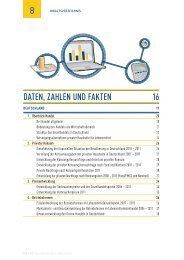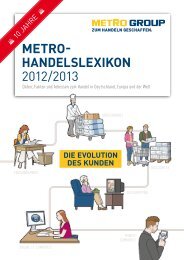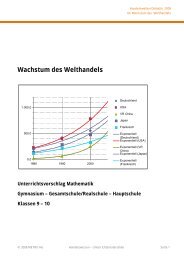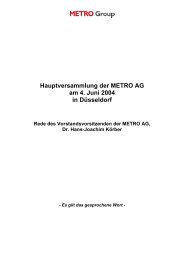pdf (22.8 MB) - METRO Group
pdf (22.8 MB) - METRO Group
pdf (22.8 MB) - METRO Group
Create successful ePaper yourself
Turn your PDF publications into a flip-book with our unique Google optimized e-Paper software.
<strong>METRO</strong> GROUP : ANNUAL REPORT 2011 : BUSINESS<br />
→ GRoUp ManaGeMenT RepoRT : 2. eConoMIC paRaMeTeRs<br />
605<br />
2. Economic parameters<br />
The global economy continued to recover in early 2011, but<br />
economic momentum weakened significantly during the<br />
second half of the year when the effects of the european and<br />
american debt crisis increasingly spread from the financial<br />
markets to the real economy. Towards the end of 2011, growing<br />
uncertainties unsettled companies and private households<br />
and dampened real economic investment. This led to<br />
stagnation in europe, capping full-year growth for 2011 below<br />
the previous year’s level. The economic weakening coupled<br />
with continued consolidation measures to stabilise public<br />
debts, including tax hikes, are weighing on disposable<br />
incomes and consumers’ purchasing power.<br />
The asian emerging markets, in particular, remained the key<br />
driver of global growth in 2011, while many developed economies<br />
experienced very sluggish economic growth. Growth<br />
trends in europe diverged as some countries recovered<br />
faster from the global financial crisis while others struggled<br />
with high public debts, in particular.<br />
Meanwhile, an increase in commodity prices during the<br />
first half of the year resulted in above-average inflation<br />
rates that only slowed slightly towards the end of the year.<br />
oil and food products, in particular, became distinctly more<br />
expensive, hurting consumers in most emerging markets<br />
where spending on food generally accounts for a high share<br />
of disposable income.<br />
Cautious outlook for consumer goods retailing<br />
Retail sales trends mirrored these challenging economic<br />
parameters. Consumer goods retailers generally experienced<br />
modest growth, particularly in Western europe. While<br />
Development of gross domestic product<br />
in key global regions and germany<br />
percentage change year-on-year<br />
2010 2011<br />
asia 7.1 3.9<br />
eastern europe 3.1 3.4<br />
Germany 3.7 3.0<br />
World 4.3 2.6<br />
Western europe (excl. Germany) 1.6 1.2<br />
source: FeRI<br />
→ p. 093<br />
the trend pointed slightly upward in eastern europe, these<br />
countries also failed to match pre-crisis growth rates. The<br />
asian emerging markets, in contrast, continued to experience<br />
strong retail sales growth in 2011.<br />
The trade industry was also hurt by the economic slowdown<br />
during the second half of the year, although the continuously<br />
low reference figures limited its effect.<br />
germany<br />
Germany remained europe’s economic growth engine in 2011<br />
with GDp growth of 3.0 percent. However, the German economy<br />
also was not immune to the general downswing and<br />
experienced a distinct slowdown towards the end of the year.<br />
While the labour market situation and disposable incomes<br />
improved throughout the year, the ongoing eurozone debt<br />
crisis temporarily dampened consumer sentiment. In addition,<br />
strong inflationary pressure squeezed real disposable<br />
incomes. as a result, private consumption once again lagged<br />
behind macroeconomic growth during the reporting year. The<br />
economy grew by a real 1.5 percent. The retail sector posted<br />
nominal growth of 2.5 percent. The price-adjusted increase,<br />
however, was less than 1 percent.<br />
western Europe<br />
In contrast to developments in Germany, economic growth in<br />
Western europe began to stall during the first half of the<br />
year and actually contracted towards the end of the year. The<br />
overall picture was marked by the divergent economic<br />
momentum of financially unstable economies and robust<br />
core countries. austria and switzerland, the Benelux states<br />
and the scandinavian countries experienced broadly solid<br />
growth in 2011. The portuguese economy, in contrast, weakened<br />
significantly, and spain and Italy also experienced only<br />
slight growth.<br />
after the Western european economies started the year on a<br />
solid growth path, the spreading of the sovereign debt crisis<br />
to Italy, portugal and spain dampened momentum during the<br />
course of the year. In addition, the austerity programmes<br />
implemented in many countries served as a brake on growth.<br />
at the same time, unemployment in the eurozone rose again<br />
in the second half of the year and reached its highest level<br />
since 1998 at the end of 2011.<br />
Unemployment and weak consumer confidence were also<br />
reflected in private consumption, which increased only<br />
slightly. Rising inflationary pressure dampened consumer

















